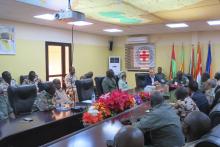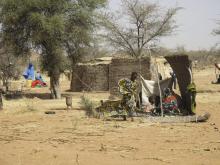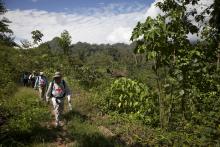Basic international humanitarian law (IHL) rules applicable to this situation:
The use of means and methods of warfare which cause superfluous injury or unnecessary suffering is prohibited.
When landmines are used, particular care must be taken to minimize their indiscriminate effects.
A party to the conflict using landmines must record their placement, as far as possible.
At the end of active hostilities, a party to the conflict which has used landmines must remove or otherwise render them harmless to civilians, or facilitate their removal.
The case in brief
Between 1998 and 1999, an armed conflict broke out in Kosovo, part of what was then the Federal Republic of Yugoslavia. Although neighbouring Albania was not a party to the conflict, parts of Albania bordering Kosovo became contaminated with landmines. The local population suffered death and injury and were unable to use the affected land for livelihood activities, hampering the region’s socio-economic development.
Albania ratified the Convention on the Prohibition of the Use, Stockpiling, Production and Transfer of Anti-Personnel Mines and on their Destruction (Ottawa Convention) in 2000.
Between 1999 and 2009 Albania removed all mines on its side of the border, thereby fulfilling the requirements of the Ottawa Convention and restoring safety to the affected areas. Its success stemmed from the joint and coordinated efforts of Albanian agencies, the United Nations Development Programme (UNDP), and international donors and mine action actors.
IHL compliance highlights
- In 1999, recognizing the need to address mine-related dangers, Albania established the Albanian Mine Action Committee (AMAC) and the Albanian Mine Action Executive (AMAE), with responsibility for national mine action policy and implementation, respectively.
- In 2002, at the government’s request, UNDP initiated a partnership with Albania to support it in meeting its treaty obligations to destroy all anti-personnel mines on its territory by August 2010. UNDP began building Albanian mine action capacity and helped formulate an action plan.
- Between 2002 and 2009, in cooperation with UNDP, AMAC and AMAE teams released more than 16 million sq m of land through survey and clearance. They destroyed 12,452 anti-personnel mines, 152 anti-tank mines and 4,965 items of unexploded ordnance. UNDP mine risk education reduced landmine injuries to zero by 2006.
- In November 2009, Albania declared it had fulfilled its Ottawa Convention obligations.
Case prepared by Emma Persson, James Patrick Sexton, Shaya Javadinia, with the contribution of Alexandra Bernard and Dewi Alexandra Delf, LL.M. students at Leiden University, under the supervision of Professor Robert Heinsch, as well as Alla Ershova (Senior Researcher) and Ashley Peltier (Researcher), Kalshoven-Gieskes Forum, Leiden University.
A. MINES CONTAMINATION STEMMING FROM THE KOSOVO CONFLICT
[Source: The Geneva International Centre for Humanitarian Demining (GICHD), ‘Transitioning Mine Action Programmes to National Ownership: Albania’, July 2012, p. 2, available at https://reliefweb.int/sites/reliefweb.int/files/resources/Albania%20Transition%20Report%202012%2007%2004%20%281%29.pdf, accessed on 31 January 2021]
[...] Albania’s landmine and UXO [Unexploded Ordnance] problem stems from the 1999 Kosovo conflict, when the armed forces of the Federal Republic of Yugoslavia (FRY) laid mines along both sides of Albania’s border with Kosovo, in its northeastern Kukës region. Cluster munitions strikes carried out by the FRY Armed Forces and NATO between April and June 1999 also contributed to the UXO problem.
Non-technical surveys carried out after the conflict identified approximately 15 km² of suspected hazardous areas along the Albanian/Kosovo border in the districts of Kukës, Has and Tropoje. A total of 39 villages and approximately 25,000 people were affected. Over 80 per cent of mine and ERW-related [Explosive Remnants of War] injuries occurred while people were engaged in livelihood activities, (eg agriculture, herding animals, collecting water). Mine/ERW contamination impeded the region’s socio-economic development and exacerbated its social and economic exclusion from the rest of the country.
[...]
B. ALBANIA REMOVES LANDMINES WITH INTERNATIONAL ASSISTANCE
[Source: Republic of Albania, ‘Declaration of Completion of Implementation of Article 5 of the Convention on the Prohibition of the Use, Stockpiling, Production and Transfer of Anti-Personnel Mines and on their Destruction’, 30 November 2009, pp. 1-2, available at: https://www.cartagenasummit.org/fileadmin/APMBC-RC2/tuesday/2RC-Item9d-1Dec2009-Albania.pdf accessed on 20 May 2022 ]
1. Albania ratified the [Ottawa] Convention on 29 February 2000. The Convention entered into force for Albania on 1 August 2000. In its initial transparency report submitted on 3 April 2002, Albania reported areas in northeast Albania that contained anti-personnel mines. In doing so, Albania acknowledged that it had an obligation under Article 5 of the Convention to destroy or ensure the destruction of all anti-personnel mines in mined areas under its jurisdiction or control as soon as possible and no later than 1 August 2010.
[...]
4. In 1999, in order to respond to the threat of anti-personnel landmines and to adequately implement mine action, an inter-ministerial body – The Albanian Mine Action Committee (AMAC) – was established. This body acted as the overall policy making body for mine action. At the same time, an operational body – the Albanian Mine Action Executive (AMAE) – was established to carry out the mine action program under direction of the AMAC.
[...]
5. From 2000-2002 demining organizations conducting humanitarian demining in Albania included RONCO, HELP, the Swiss Foundation for Demining (FSD) and Dan Church Aid (DCA). It is estimated that approximately 2 million square meters of dangerous area was released by these organizations during 2000-2001 through manual clearance, impact and technical surveys.
6. The period of 2002 and 2003 were important years in terms of capacity building of the national program. In April 2002, upon request from the Government of Albania, a United Nations Development Programme (UNDP) capacity building program was initiated aimed at building sustainable local capacities for coordination and monitoring of mine action activities. Additionally, in June 2002, an important workshop was held to formulate a vision, mission, priorities and a mine action plan with the vision of Albania being mine and UXO free by 2010.
[...]
7. During 2002-2003, DCA and FSD were deployed for demining in Albania. With increased coordination and more efficient utilization of demining assets, about 9,000,000 square meters of contaminated land was released through impact/technical surveys and clearance operations during these years. The demining assets of DCA and FSD consisted of survey and manual demining teams, demining machines (Bozena 1 mini-flail and an ML-1 medium flail) and mine detection dogs.
[...]
9. From 2004 until fulfilment of Albania’s mine clearance obligations, mine clearance operations have been conducted by DCA in accordance with the National Demining Plan and Priorities. Late in 2004, DCA expanded its capacities in also conducting battle area clearance.
[...]
10. As a result of efforts undertaken since Albania submitted its initial transparency report, Albania declares that it has fulfilled its obligations under Article 5 of the Convention by having determined that there are no longer areas under the jurisdiction or control of Albania in which anti-personnel mines are known or suspected to be emplaced. Upon declaring completion, 16,608,055 million square meters of area in which anti-personnel mines and unexploded ordnance were known or were suspected to be emplaced has been released through survey and clearance. This work has culminated in the destruction of 12,452 anti-personnel mines, 152 anti-tank mines and 4,965 UXOs.
[...]
[Source: International Trust Fund for Demining and Mine Victims Assistance, ‘Demining Albania’, November 2009, pp. 11, 12 and 16, available at https://www.itf.si/upload/publications/demining_albania_2000_2009.pdf, accessed on 31 January 2021]
[...] The needs in the affected countries can only be addressed properly by creating and developing a well-balanced mine action programme, which enables the mine-affected countries to effectively confront and address the mine problem. Over the years, AMAE has received support from several international donors.
[...]
There is no general system or modus operandi, which ensures the successful resolution of any single country’s mine problem. In the Albanian case, though, it was the joint and coordinated efforts of all stakeholders, i.e. ITF [International Trust Fund for Demining and Mine Victims Assistance], AMAE , DCA [DanChurchAid], and every single donor contributing to these efforts, which rendered the project successful.
[...]
[Source: The Cartagena Summit on a Mine-Free World, ‘Albania announces that it is free of anti-personnel mines’, 8 October 2009, available at https://www.cartagenasummit.org/press-room/press-releases/8-october-2009-english/, accessed on 31 January 2021]
[...] “Today we can say that the vision of an Albania free from anti-personnel mines has come true.” According to Petrit Karabina, Chairman of the Albanian Mine Action Committee, his country has become the second state in South Eastern Europe to have cleared all its known mined areas in accordance with its obligations under the Anti-Personnel (AP) Mine Ban Convention.
“After almost a decade of work, Albania is proud that it has fulfilled its Convention obligations well before its deadline,” said Karabina. “Over 14 million square metres of land that had been mined have been released for normal human activity. People in Northeast Albania, can return to normality, and once again move freely, use their farm lands and feel safe.” According to Karabina, by demining contaminated areas, Albania demonstrates “it is willing to promote peace in the South Eastern Region.”
[...]
C. IMPACT OF DEMINING ON LOCAL COMMUNITIES
[Source: International Trust Fund for Demining and Mine Victims Assistance, ‘Demining Albania’, November 2009, p. 15, available at https://www.itf.si/upload/publications/demining_albania_2000_2009.pdf, accessed on 31 January 2021]
[...] The post-clearance assessments were initiated by DCA in May 2009 across all DCA cleared minefields and BAC strike areas. Until the end of October 2009, 74 sites were visited and 374 interviews have been conducted in total. Preliminary results for the surveyed sites show that the main obstacles caused by landmines have been removed as a result of DCA clearance activities. This today provides access to grazing land, access to natural resources (firewood, fruit, herbs, etc.) and access to paths/roads and bridges. The assessment also shows that there is a very high degree of trust in the cleared land and that the land is being used again.
[...]
[Source: United Nations Development Programme, ‘Albanians stranded by landmines to restart lives’, 16 February 2011, available at: Link not available.]
[...] Thousands of villagers in one of the poorest regions of Albania are to reclaim their livelihoods after a partnership between government agencies and the United Nations Development Programme (UNDP) successfully cleared more than 12,000 anti-personnel mines from 16 million square metres of land.
Some 25,000 people in three districts of northeast Albania, along the mountainous border with Kosovo, will be able to return to agriculture and farming activities free from the threat of hidden explosive devices which have injured 238 people and killed 34 since 1999, the year of the 78-day conflict over Kosovo.
[…]
“Now this area is free,” said Rama Basha, representative of Shishtavec Commune in Kukes, one of the most heavily mined areas along the border. “The community is hard-working and eager to use their land and cultivate the area. This is the priority.”
The 7-year minefield clearance effort was carried out by UNDP-supported teams from the national Albanian Mine Action Committee and the Albanian Mine Action Executive.
UNDP held workshops for vulnerable communities, providing education on avoiding the risks of buried or unexploded weapons. As a result, the number of mine accidents decreased from 154 in 1999 to zero by 2006.
UNDP also offered landmine survivors help in gaining medical care, rehabilitation and access to social services and prosthetics. It helped survivors find new livelihoods, for example providing training in animal husbandry.
“The community in Albania can now make use of their land and feel safe,” said Petrit Karabina, Chair of the Albanian Mine Action Committee and Deputy Minister of Defense, whose government requested efforts to clear the minefields in 2003.
Discussion
I. Classification of the Situation and Applicable Law
- How would you classify the situation in Kosovo between 1998-1999? (GC I-IV, Art. 2, Art. 3; P I, Art. 1; P II, Art.1)
- Why do you think Albania was required to neutralise all anti-personnel landmines under the Ottawa Convention despite not being involved in the Kosovo conflict? Does this mean that some IHL obligations apply regardless of whether an actor is a party to an armed conflict? (Ottawa Convention, Art. 1, Art. 5)
- What rules of IHL govern landmines? Are the rules on anti-personnel landmines the same for both international and non-international armed conflicts? (Ottawa Convention, Art. 1; PI, Art. 35; CCW, Art. 1; CCW Amended Protocol II, Art. 1; CCW Protocol V; CIHL Rules 70, 81, 82, 83)
II. Demining Action
- What time limit does the Ottawa Convention set for State parties to remove anti-personnel mines? Is there an option to request an extension? Did Albania request such an extension, or did it remove all mines within the time it originally intended? (Ottawa Convention, Art. 5)
- Albania’s demining project was assisted by several international actors. Did Albania have the right to seek their assistance? If so, were such actors obliged to assist? What is the difference between a right and an obligation under IHL? (Ottawa Convention, Art. 6)
III. Elements Contributing to Respect for IHL
- (Document B, Source 3; Document C) Many inhabitants of the region affected by mines relied on the land for economic survival. In your opinion, to what extent was Albania's demining motivated by the fact that the contaminated land was vital for economic purposes? Based on the sources above, do you think Albania's actions would have changed if the land had been uninhabited?
- (Document B, Source 1) Why do you think that there is a ten-year time limit included in the Ottawa Convention? Does this put pressure on the States to act? Do you think Albania would have acted differently without the time limit?
- (Document B, Source 2; Document C) What impact, if any, might international public opinion have had on Albania’s decision to remove anti-personnel mines? To what extent do you think that funding and support from international actors aided Albania’s demining programme?
- (Document B, Source 3) Albania stated that, through its demining programme, it demonstrated that “it is willing to promote peace in the South Eastern Region” of Europe. To what extent do you think this programme might have eased tensions in the region? Do you think demining in general is an effective way of promoting peace?




